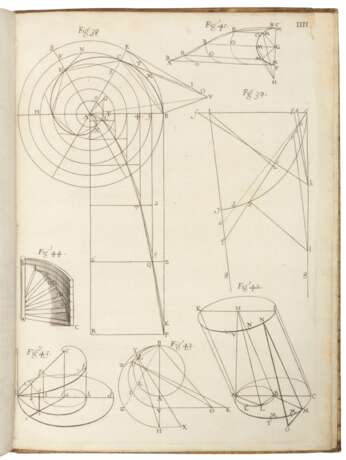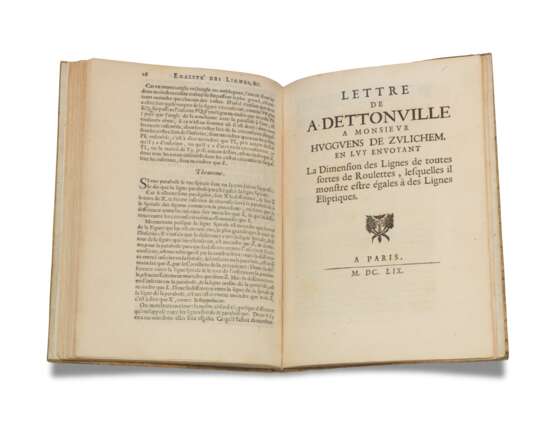ID 519326
Lot 36 | Blaise Pascal (1623-1662).
Estimate value
£ 30 000 – 50 000
Lettres de A. Dettonville contenant quelques-unes de ses inventions de geometrie. Paris: Guillaume Desprez, 1659.
Very rare first edition of Pascal’s theory of indivisibles, a forerunner of integral calculus. After using his perfected method of indivisibles to solve several infinitesmal problems concerning the cycloid, Pascal decided to challenge the leading mathematicians of his day with these same problems. At the end of the contest Pascal published his own superior solutions in four letters published in December 1658 and January 1659 under the pseudonym A. Dettonville (an anagram of Louis de Montalte, a pseudonym under which he had published his Les Provinciales). In February 1659 these four pamphlets were collected in the Lettres de A. Dettonville. ‘This publication of some 120 pages has a very complex structure. The first of the Lettres consists of five sections with independent paginations, and the three others appear in inverse order of their composition. Thus only by returning to the original order is it possible to understand the logical sequence of the whole, follow the development of Pascal's method, and appreciate the influence on it of the new information he received and of his progress in mastering infinitesimal problems.’
‘The most notable characteristics of this work [...] are the importance accorded to the determination of centres of gravity, the crucial role of triangular sums and statical considerations, its stylistic rigor and elegance, and the use of clear and precise geometric language that partially compensates for the absence of algebraic symbolism. Among outstanding contributions of the work are the discovery of the equality of curvature of the generalized cycloid and the ellipse; the deepening of the concept of the indivisible; a first step toward the concept of the definite integral and the determination of its fundamental properties; and the indirect recourse to certain methods of calculation, such as integration by parts’ (DSB). Norman 1649.
Half-sheet quarto (242 x 175mm). 4 folding engraved plates (light staining to upper section of plates). Early vellum (recased).
| Address of auction |
CHRISTIE'S 8 King Street, St. James's SW1Y 6QT London United Kingdom | |
|---|---|---|
| Preview |
| |
| Phone | +44 (0)20 7839 9060 | |
| Buyer Premium | see on Website | |
| Conditions of purchase | Conditions of purchase |





